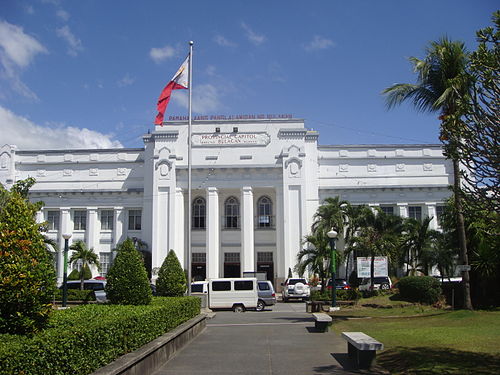Juan M. Arellano | |
|---|---|
 | |
| Born | Juan Marcos Arellano y de Guzmán (1888-04-25)April 25, 1888 |
| Died | December 5, 1960(1960-12-05) (aged 72) |
| Other names | Juan Arellano |
| Alma mater | Drexel Institute Ateneo de Manila University |
| Occupation | Architect |
| Organization | Philippine Institute of Architects |
| Known for | Neoclassical andArt Deco buildings |
| Spouse | Natividad Ocampo |
| Parent(s) | Luis C. Arellano Bartola de Guzmán |
| Awards | Medal of Merit Awardee, Philippine Institute of Architects |
| Honours | 5th President, Philippine Institute of ArchitectsPrecursor of the 1st Architectural Exposition in Asia |
Juan Marcos Arellano y de Guzmán (April 25, 1888 – December 5, 1960), orJuan M. Arellano, was aFilipinoarchitect, best known forManila'sMetropolitan Theater (1935), Legislative Building (1926; now houses theNational Museum of Fine Arts), theManila Central Post Office Building (1926), theRizal Memorial Sports Complex (1934), the Central Student Church (today known as theCentral United Methodist Church, 1932), the oldJaro Municipal Hall (1934) and theOld Iloilo City Hall (1935) in Iloilo, theNegros Occidental Provincial Capitol (1936), theCebu Provincial Capitol (1937),Dumaguete Presidencia (1937), the Bank of the Philippine Islands Cebu Main Branch (1940),Misamis Occidental Provincial Capitol Building (1935),Cotabato Municipal Hall (1940) and theJones Bridge during the pre-war era.
This sectiondoes notcite anysources. Please helpimprove this section byadding citations to reliable sources. Unsourced material may be challenged andremoved. Find sources: "Juan M. Arellano" – news ·newspapers ·books ·scholar ·JSTOR(November 2022) (Learn how and when to remove this message) |
Juan M. Arellano was born on April 25, 1888, inTondo, Manila,Philippines to Luis C. Arellano and Bartola de Guzmán. Arellano married Natividad Ocampo on May 15, 1915. He had eight children, Oscar, Juanita, Cesar, Salvador, Juan Marcos, Luis, Gloria and Carlos.
He attended theAteneo Municipal de Manila and graduated in 1908. His first passion waspainting and he trained under Lorenzo Guerrero, Toribio Antillon, and Fabian de la Rosa.[1] However, he pursuedarchitecture and was sent to theUnited States as one of the firstpensionados in architecture, after Carlos Barreto, who was sent to theDrexel Institute in 1908; Antonio Toledo, who went toOhio State; andTomás Mapúa, who went toCornell.
Arellano went to thePennsylvania Academy of the Fine Arts in 1911 and subsequently transferred toDrexel to finish hisbachelor's degree in Architecture. He was trained in theBeaux Arts and subsequently went to work forGeorge B. Post & Sons inNew York City, where he worked forFrederick Law Olmsted Jr.[2]
He then returned to the Philippines to begin a practice with his brother,Arcadio. He later joined theBureau of Public Works just as the last American architects, George Fenhagen and Ralph H. Doane, were leaving. He andTomás Mapúa were then named as supervising architects. In 1927, he took a study leave and went to the United States where he was greatly influenced byArt Deco architecture.
In 1930, he returned to Manila and designed theBulacan Provincial Capitol and notably theManila Metropolitan Theater, which was then considered controversiallymoderne.[3] He continued to act as a consulting architect for the Bureau of Public Works where he oversaw the production of the Manila's firstzoning plan. In 1940, he and Harry Frost created a design forQuezon City, which was to become the newcapital of the Philippines.

It was during that time that he designed the building that would house the United States High Commission to the Philippines, later theEmbassy of the United States in Manila. He designed ademesne along the edge ofManila Bay, which featured amission revival style mansion that took advantage of the seaside vista.[4] The Americans instead opted for afederal-style building that ended up overpriced and uncomfortable.
DuringWorld War II, the Legislative Building and Jones Bridge, were totally destroyed and the Post Office Building was severely damaged. While these structures were all reconstructed, his original designs were not followed and were considered poor replications.[5]
Arellano retired in 1956 and went back to painting. In 1960, he exhibited his work at the ManilaYMCA.
He died at the age of 72 on December 5, 1960.
 Media related toJuan M. Arellano at Wikimedia Commons
Media related toJuan M. Arellano at Wikimedia Commons